kart throttle cable
The Importance of Kart Throttle Cables
When it comes to kart racing, every component plays a critical role in the performance of the vehicle. Among these components, the throttle cable might seem like a mere accessory, but its importance cannot be overstated. The throttle cable is the vital link between the driver's input and the engine's response, significantly affecting the kart's speed, handling, and overall driving experience.
Functionality of the Throttle Cable
The primary function of the throttle cable is to control the engine's air intake and fuel delivery based on the driver's pressure on the accelerator pedal. When the driver presses down on the pedal, the throttle cable pulls on the throttle body, opening the butterfly valve that allows more air and fuel mixture into the engine. This action results in increased power and acceleration, enabling the kart to reach higher speeds.
Moreover, the throttle cable serves as a precise mechanism that translates driver intentions into engine output. A well-functioning throttle cable will provide a smooth increase in speed, whereas a worn or improperly adjusted cable can lead to sluggish acceleration or erratic throttle response. Therefore, maintaining the integrity of the throttle cable is essential for competitive karting.
Types of Throttle Cables
There are generally two types of throttle cables used in karting manual and electronic. Manual throttle cables are the traditional setup, consisting of a physical cable connecting the accelerator pedal to the throttle body. This system is appreciated for its simplicity, reliability, and the direct mechanical connection it provides, allowing drivers to feel every bit of power delivered from the engine.
kart throttle cable

On the other hand, electronic throttle control (ETC) uses sensors to detect the position of the accelerator pedal and sends signals to the engine control unit (ECU). The ECU then adjusts the throttle position accordingly. While this system allows for more precise control and can aid in fuel efficiency and emissions management, it can sometimes lead to a disconnect between driver input and engine response. As such, many kart racers prefer the feel of manual throttle cables.
Maintenance of Throttle Cables
Regular maintenance of the throttle cable is crucial for optimal performance. This involves checking for fraying or wear, ensuring the cable is properly lubricated, and confirming that it is correctly adjusted. If the cable is too loose, it may lead to delayed throttle response. Conversely, if it is too tight, it may cause excessive strain on other components or lead to unintended acceleration.
It is also wise to inspect the cable’s housing for any damage or obstruction. Dirt and debris can hinder the movement of the cable, adversely affecting throttle response. During routine maintenance, it is recommended to examine the connection points at both the pedal and throttle body to ensure they are secure and free from corrosion.
Conclusion
In the realm of kart racing, every element counts, and the throttle cable is a key player in the system. Its role is not only fundamental in delivering power to the engine but also in enhancing the overall driving experience. Drivers should be mindful of the condition and adjustment of their throttle cables, as this small yet vital component can significantly impact performance.
Whether you are a seasoned racer or just starting, understanding the importance of the throttle cable can help improve your kart's responsiveness and reliability, giving you a competitive edge on the track. Remember, in racing, it’s not just about the power of the engine but also about how effectively that power is transferred to the wheels—and a well-maintained throttle cable is essential for that transfer.
-
Workings of Clutch Pipe and Hose SystemsNewsJun.04,2025
-
The Inner Workings of Hand Brake Cable SystemsNewsJun.04,2025
-
The Secrets of Throttle and Accelerator CablesNewsJun.04,2025
-
The Hidden Lifeline of Your Transmission Gear Shift CablesNewsJun.04,2025
-
Demystifying Gear Cables and Shift LinkagesNewsJun.04,2025
-
Decoding Clutch Line Systems A Comprehensive GuideNewsJun.04,2025
